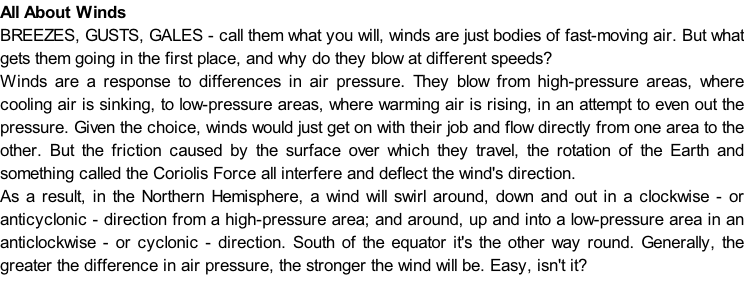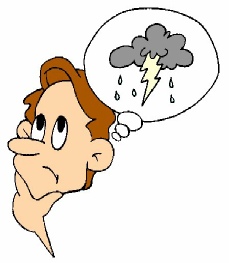








Weather lore
Uneducated and without either the resources or leisure time to perform scientific experiments, ordinary people once relied on careful observation of nature to predict the weather, and a whole body of weather lore developed. Here are just a few examples...
It will be rainy and stormy if:
flowers close up.
the cows are lying down.
there's a ring of cloud around the moon.
the swallows fly low (if they are flying high, the winds are light)
It will turn into a fine day if:
it rains before seven.
it's foggy in the morning.
Winter will be severe if:
squirrels store large quantities of nuts.
squirrels have bushy tails.
there are lots of berries on the trees.
ant hills are high in July.
hornets build their nests high.
Answers for Weather Instruments:
1d 2h 3f 4g 5a 6c 7i 8e 9b
The air we breathe
The oldest gases in the atmosphere include carbon dioxide, nitrogen, methane, and the so-
Using the power of the sun in a chemical process called photosynthesis, these bacteria absorbed carbon dioxide from the atmosphere and gave off a new gas: oxygen. Some of this oxygen was converted to ozone, which then formed a protective shield against the sun's harmful ultraviolet light, making it possible for more complex life forms – including human beings – to develop.
Now, around 78 per cent of the air in the atmosphere is made up of nitrogen and 21 per cent of oxygen. The remainder is composed of other gases, water vapour, aerosols (solid particles such as dust, viruses and bacteria), and minute quantities of highly reactive molecules such as the hydroxyl radical (OH). OH is important because it helps to clear the atmosphere of pollutants such as hydrocarbons.
The Shipping Forecast
`And now the shipping forecast, issued by the Met Office on behalf of the Maritime and Coastguard Agency at double-
Who would have thought the bare bones of weather warnings for coastal shipping, broadcast at the unsocial extreme ends of the day's radio schedules, could have become such a national icon? The forecasts are easy to decode if you know what each phrase refers to. First comes the wind direction and speed, then the sea state, then the weather, and finally visibility. 'Southerly, veering westerly 5 or 6, occasionally variable 7 later... Moderate or rough... Occasional drizzle... Good.' The list of locations goes like this:
Bailey – Biscay – Cromarty – Dogger – Dover – Faeroes – Fair Isle – Fastnet – Fisher – FitzRoy (formerly Finisterre) – Forth Forties – German Bight – Hebrides – Humber – Irish Sea – Lundy – Malin – North Utsire – Plymouth – Portland – Rockall Shannon – Sole – South Utsire – Southeast Iceland – Thames Trafalgar – Tyne – Viking – Wight
Jet Streams
WAY UP IN the atmosphere, currents of fast-
Jet streams occur about 10-
Instead of flowing directly from warm to cold, however, jet steams are deflected by the Earth's spin and travel along the boundaries between the two masses, taking a meandering path. The main jet streams usually flow from west to east but sometimes they can change to almost north to south -
The position of the jet streams is a clue to where the strongest contrast in surface temperature lies. The contrast is greatest in winter, so this is when the streams are fastest, accelerating to 300 miles an hour or more -
Precipitation
Precipitation is, if you'll pardon the pun, an umbrella term for water that falls to earth in whatever form. There are a surprising number of different types including:
Drizzle — strictly speaking, raindrops smaller than about 1/50 inch (0.5mm) are drizzle.
Freezing rain, freezing drizzle — rain or drizzle that freezes when it hits a solid object, leaving a layer of glaze ice.
Hail — defined as solid balls of ice between 1/5 inch and (believe it or not) 6 inches (5-
Ice pellets, small hail — small translucent balls of ice, smaller than hail.
Sleet. — in the UK, sleet refers to snow that melts as it falls, i.e. rain and snow mixed; however, in US parlance, it normally means ice pellets.
Snow pellets, soft hail, graupel — formed when super-
Snow grains, granular snow — very small (under 1mm) grains of ice, like small solid drizzle, but falling in small quantities from stratus clouds or fog rather than a shower from a convective cloud.
Thundersnow — snow rather than rain falling during a thunderstorm.
|
Weather Instruments Link these weather instruments with their occupation: 1. Barometer 2. Thermometer 3. Psychometer 4. Anemometer 5. Wind vane/sock 6. Weather balloon 7. Weather satellite 8. Rain gauge 9. Campbell Stokes Recorder |
a. Measures wind direction b. Measures sunshine c. Measures weather in higher atmospheres d. Measures air pressure e. Measures rain and snow f. Measures relative humidity g. Measures wind speed h. Measures air temperature i. Photographs & tracks large movements of air Answers below the next item. |
